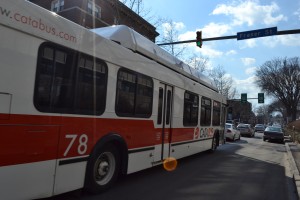As the fall semester approaches at Penn state university, Cata Bus schedules become more guidelines than actual rules. With new drivers, less timely arrivals, and riders who play the role of navigators, students are growing increasingly agitated with the system. During the school year, senior Penn State student Anel said the loop bus rarely follows the schedule and passes students who rely on the CATA bus to get to class.
“If the bus gets there [at the stop] early and there isn’t anyone there, it leaves right away. If the bus arrives at 9:37 and is supposed to come at 9:40, it won’t wait,” Anel said. Even if the buses do make a timely arrival, the student-traffic is so heavy, two loop buses hardly allow every student to make it past the yellow safety line at the front of the bus. Shouldn’t students be behind the yellow safety line?
While the majority of CATA related complaints happen during the school year, summer riders are also frustrated by the lack of loop-bus activity. Lasita, a PSU graduate student, notes that the blue loop in particular should be more frequent.Why?
The online community is also accumulating traffic when discussing the CATA system’s kinks. A student, whose profile is titled “I Hate Penn State,” wrote on his Twitter page about a wayward route: “This green link thinks it’s the Vairo bus.”
The green link, an on-campus CATA bus route, strayed off campus and towards Wal-Mart—the Vairo bus’s main stop. Among other CATA-shaming comments were “Whenever you’d like to get here, CATA bus. Not like I have to be at work on time,” and “CATA’s iPhone app has been updated for the Fall semester. You will now be able to miss your bus with greater accuracy.”
CATA’s Ride Guide notes that arrival and departure times depend on the weather. CATA representativess were not available to comment on the accuracy of the buses’ timing; however, although driving safety is a priority, some riders have suggested that a slight mist in May doesn’t excuse a bus that arrives twenty minutes late.
Due to the perceived lack of student activity, CATA severely limits its ride options during the summer months. Sophomore and State College native Maria Landschoot is irritated by the erratic ride schedule, as she relies on the W route to travel to and from her home.
“The W bus is all over the place,” Landschoot says. “They don’t run on Sundays, and other buses do…so it’s not like CATA is incapable of finding people who want to drive on Sundays.”
Even routes that do run on Sundays are so restricted that riders find themselves having to wait hours just to get a bus.
The level of expertise amongst drivers can make or break the swiftness of an already limited schedule. As new drivers take on unfamiliar routes, the “stop requested” ding proves useless to the riders. Those who want to get off at a particular stop have to alert the driver multiple times before the bus slows down.
“The CATA bus needs to take a good long look at itself, and standardize its service,” Landschoot adds. For those who rely on the CATA bus for transportation to work and important appointments, the lack of a clear system draws the line between students who are perceived as professional versus viewed as too lax, as those commuting by bus struggle to arrive at work on time.
One person who supports the CATA bus system is Ian Marshall, a professor at Penn State Altoona who lives in State College. He is impressed by the timely arrivals of the buses and the accessibility of the stops.
“In a city this size, we’re fortunate to have a bus service that’s this good,” Marshall says. Despite the fact that the bus closest to his home seldom runs, Marshall notes that more popular bus stops are never farther than a ten minute walk from his house. He said he has always been able to rely on the busses to arrive promptly.
“They [the buses] are so on time, that if I don’t get there on time, I’ve missed it,” Marshall adds jokingly.
However, judging by the anti-CATA Bus activity downtown and on social networking sites, CATA’s summer scheduling results more often in moans and groans rather than sounds of encouragement. Often, people point out that relying on the CATA system results in unnecessary guesswork and waiting around for a bus that was supposed to arrive twenty minutes earlier.
